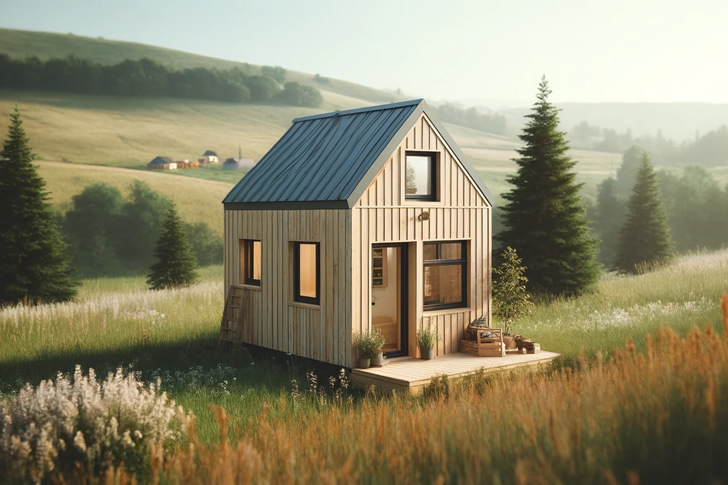How To Get A Cheap Tiny House For Seniors
Tiny houses offer seniors a budget-friendly, simplified lifestyle, tailored to personal comfort and efficiency.

Introduction
For many seniors, the appeal of downsizing to a tiny house lies not only in its affordability but also in the reduced maintenance and energy costs. This guide will explore how to secure a cost-effective tiny house, considering prefabricated options, custom designs, and the unique aspects of tiny house living for seniors.
Understanding Tiny Houses
A tiny house typically measures between 100 and 400 square feet and can come in various styles, such as on wheels for mobility or set on a foundation for a more permanent setting. These homes are not only economical but also environmentally friendly and incredibly versatile in design and functionality.
Benefits of Tiny House Living for Seniors
- Cost-Effectiveness: Less expensive than traditional homes to purchase and maintain.
- Simplicity: Smaller space encourages a simpler lifestyle with fewer possessions.
- Mobility: Tiny houses on wheels allow owners to travel or move residences without leaving home behind.
- Community: Many tiny house communities offer a close-knit environment with shared spaces and activities.
Types of Tiny Houses
Prefabricated Tiny House
Prefabricated tiny houses are manufactured off-site and delivered ready to be moved into, which can significantly reduce construction time and cost. These models are popular for their convenience and often come with pre-installed utilities.
Tiny House Designs
Tiny house designs can range from rustic tiny wood houses that blend with natural surroundings to modern designs with innovative uses of space and technology. Effective design is crucial in a tiny house, as space must be maximized without sacrificing comfort.
Building a Tiny House
Building a tiny house can be a rewarding project. For those who choose to build from scratch, the cost can vary widely based on materials, features, and whether you hire professionals or undertake much of the work yourself.
Small House on Wheels
A tiny house on wheels offers the ultimate flexibility, allowing owners to change their location as desired. These homes are built on trailer bases and can be designed to meet the specific needs and style preferences of the owner.
The Feel of Living in a 10-Ft Wide Tiny House
Living in a 10-foot wide tiny house often feels cozier and more intimate than traditional homes. Creative storage solutions and multi-functional furniture are key to making the most of the space, providing a comfortable living environment that feels open and organized.
Cost Considerations and Tips
Budgeting for a Tiny House
When planning for a tiny house, it’s important to budget not only for the house itself but also for land (unless planning to rent space), permits, and any site preparation needed. The total cost can range from $30,000 to $60,000 on average, significantly less than that of a typical home.
Financing a Tiny House
Financing can be a challenge, as many banks do not offer mortgages for tiny houses. Alternative options include personal loans, manufacturer financing, or savings. Some builders also offer payment plans.
Examples of Tiny Houses Across the U.S.
Here are ten examples of tiny house costs and features in various U.S. districts:4
- Portland, OR: $45,000; features solar panels and compost toilet.
- Austin, TX: $40,000; modern design with a retractable bed and full kitchen.
- Asheville, NC: $50,000; rustic wood design, community living amenities.
- San Diego, CA: $55,000; coastal theme, high-end appliances.
- Denver, CO: $38,000; mountain style, energy-efficient windows.
- Orlando, FL: $35,000; hurricane-resistant build, lightweight materials.
- Seattle, WA: $47,000; rainwater collection system, green roof.
- Madison, WI: $30,000; traditional cabin look, wood stove.
- Boise, ID: $42,000; minimalist design, fold-out deck.
- Albuquerque, NM: $34,000; desert style, thermal mass heating.
Special Considerations for Seniors
Seniors should consider accessibility features such as ramps, grab bars, and possibly a bedroom on the main floor to accommodate mobility needs. It’s also wise to check local zoning laws, which can vary widely and may restrict where tiny houses can legally be placed.
Conclusion
Tiny houses represent a practical, economical solution for seniors looking to simplify their lives. Whether prefabricated or custom-built, these homes offer flexibility, community, and the opportunity to live sustainably. By carefully planning and researching, seniors can transition into tiny house living smoothly, enjoying their golden years in comfort and style.







Recent Comments